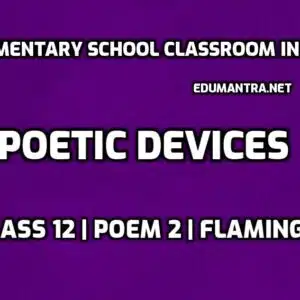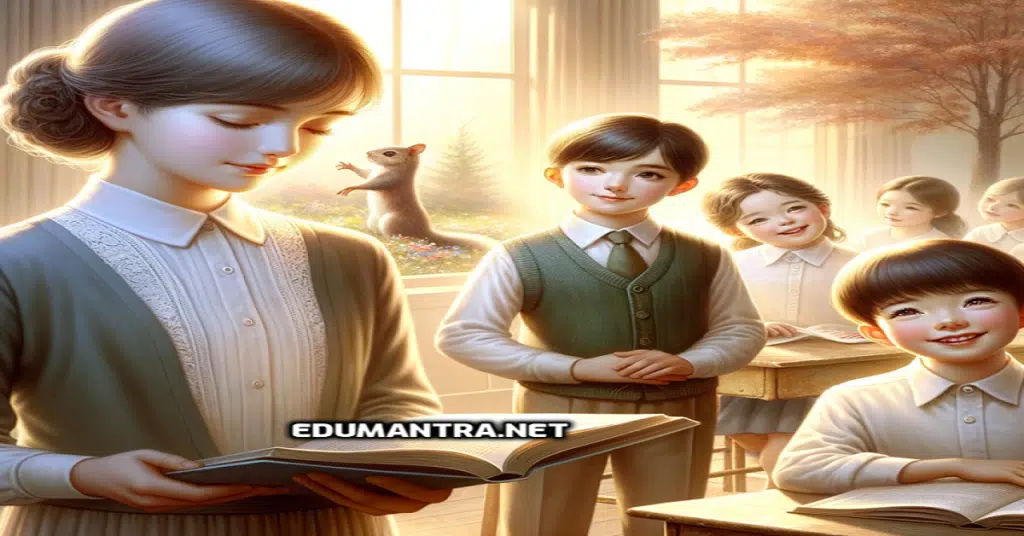
Here is An Elementary School, a detailed exploration and explanation of the figure of speech and its many facets. In this post, we have explained various examples of figurative speech, providing a comprehensive understanding of An Elementary School in terms of all Poetic Device. We have also told the reason why a particular figure of speech occurs in a particular line. This is going to help the children of various classes Class XII. Dive in for figure of speech examples-
Table of Contents
Figure of Speech in An Elementary School Stanza 1
Far far from gusty waves these children’s faces.
Like rootless weeds, the hair torn round their pallor:
The tall girl with her weighed-down head. The paper-
seeming boy, with rat’s eyes. The stunted, unlucky heir
Of twisted bones, reciting a father’s gnarled disease,
His lesson, from his desk. At back of the dim class
One unnoted, sweet and young. His eyes live in a dream
Of squirrel’s game, in tree room, other than this.
1.Figure of Speech- Repetition
Exact Line: “Far far from gusty waves these children’s faces.”
Reason: The repetition of “far” emphasizes the great distance, both literal and metaphorical, between the children and the more prosperous parts of the world.
2.Figure of Speech-Simile
Exact Line: “Like rootless weeds, the hair torn round their pallor”
Reason: This simile compares the children’s hair to rootless weeds, emphasizing their neglected state and vulnerability, similar to weeds without roots.
3.Figure of Speech-Metaphor
Exact Line: “The paper-seeming boy, with rat’s eyes.”
Reason: Here, the boy is metaphorically described as appearing like paper, indicating his frailty and insubstantial presence, alongside a comparison of his eyes to those of a rat, which might suggest cunning or survival instincts in harsh conditions.
4. Figure of Speech-Imagery
Exact Line: “The tall girl with her weighed-down head.”
Reason: This line creates a vivid visual image of the girl, burdened either by physical or psychological weight, implying hardship.
5.Figure of Speech-Metaphor
Exact Line: “The stunted, unlucky heir of twisted bones, reciting a father’s gnarled disease,”
Reason: This metaphor suggests inheritance of suffering and illness, indicating a cycle of poverty and poor health.
Also Read:
- An Elementary School Classroom in a Slum Extra Questions and Answers
- An Elementary School Classroom in A Slum MCQ Online Test
- An Elementary School Classroom in A Slum Short Questions and Answers
- An Elementary School Classroom in A Slum Extract Based Questions
6.Figure of Speech- Metaphor
Exact Line: “Of squirrel’s game, in tree room, other than this.”
Reason: This metaphor contrasts the child’s dream with the reality of the classroom, showing his mental escape into a more pleasant, natural world.
7.Figure of Speech- Personification
Exact Line: “His eyes live in a dream”
Reason: This personifies the boy’s eyes as living in a dream, illustrating a stark contrast between his hopeful imagination and the grim reality of his surroundings.
8.Alliteration
Exact Line: “stunted, unlucky heir”
Reason: The repetition of the ‘un’ sound in “stunted, unlucky” underscores the dismal condition of the child.
9. Figure of Speech: Juxtaposition
Exact Lines:
– “Like rootless weeds, the hair torn round their pallor”
– “The paper-seeming boy, with rat’s eyes.”
Reason: The juxtaposition of vulnerable imagery (“rootless weeds,” “paper-seeming boy”) with more resilient or harsh imagery (“rat’s eyes”) underscores the complex nature of the children’s existence. It highlights their fragility juxtaposed with the necessity for toughness in their environment.

10. Figure of Speech: Symbolism
Exact Line: “rat’s eyes”
Reason: The term “rat’s eyes” symbolizes more than just a physical characteristic; it can imply a life of scavenging, survival, and being marginalized, reflecting the challenging conditions the children face.
11. Figure of Speech: Oxymoron
Exact Line: “The stunted, unlucky heir”
Reason: Describing someone as both “stunted” and an “heir” combines contradictory ideas—limited growth and inheritance—creating an oxymoron that emphasizes the irony of inheriting undesirable traits or conditions.
Also Read:
- An Elementary School Classroom in A Slum Theme
- An Elementary School Classroom in A Slum Author
- An Elementary School Classroom in A Slum MCQ
- An Elementary School Classroom in A Slum Summary
An Elementary School Poetic Device- Stanza- 2
On sour cream walls, donations. Shakespeare’s head,
Cloudless at dawn, civilized dome riding all cities.
Belled, flowery, Tyrolese valley. Open-handed map
Awarding the world its world. And yet, for these
Children, these windows, not this map, their world,
Where all their future’s painted with a fog,
A narrow street sealed in with a lead sky
Far far from rivers, capes, and stars of words.
1.Figure of Speech: Metaphor
Exact Line: “On sour cream walls, donations.”
Reason: The metaphor of ‘sour cream walls’ suggests the walls’ dullness and staleness, implying a lackluster and uninspiring environment.
2.Figure of Speech: Allusion
Exact Line: “Shakespeare’s head,”
Reason: This is an allusion to William Shakespeare, referencing the common practice of displaying his portrait in classrooms as a symbol of literary and cultural education.
3.Figure of Speech: Assonance
Exact Line: “Belled, flowery, Tyrolese valley.”
Reason: The repetition of the vowel sound ‘e’ in “Belled, flowery, Tyrolese” creates a musical quality and emphasizes the beauty and idealism of the imagery, contrasting with the children’s reality.
4.Figure of Speech: Metaphor
Exact Line: “A narrow street sealed in with a lead sky”
Reason: This metaphor describes the children’s future as a ‘narrow street’ under a ‘lead sky,’ symbolizing their limited and oppressive prospects.
5.Figure of Speech: Irony
Exact Line: “And yet, for these Children, these windows, not this map, their world,”
Reason: There is a stark irony here as the literal windows of the classroom show the grim reality of the slum, contrasting with the expansive world shown on the map.
6.Figure of Speech: Repetition
Exact Line: “Far far from rivers, capes, and stars of words.”
Reason: The repetition of “far far” emphasizes the vast distance between the children’s present reality and the wider, more prosperous world.
7.Figure of Speech: Allusion
Exact Line: “Tyrolese valley.”
Reason: This is an allusion to the Tyrolese Valley, a reference to a specific geographic location that symbolizes natural beauty and a world beyond the classroom.
Figures of Speech Poem – An Elementary School Stanza- 3
Surely, Shakespeare is wicked, the map a bad example.
With ships and sun and love tempting them to steal —
For lives that slyly turn in their cramped holes
From fog to endless night? On their slag heap, these children
Wear skins peeped through by bones and spectacles of steel
With mended glass, like bottle bits on stones.
All of their time and space are foggy slum.
So blot their maps with slums as big as doom.
1.Figure of Speech: Irony
Exact Line: “Surely, Shakespeare is wicked, the map a bad example.”
Reason: This line employs irony to criticize the disconnect between the idealized world of education and the grim reality of children’s lives.
2. Figure of Speech: Metaphor
Exact Line: “For lives that slyly turn in their cramped holes”
Reason: This metaphor describes the children’s homes as ‘cramped holes,’ emphasizing the small, confined, and inadequate living conditions.
3. Figure of Speech: Simile
Exact Line: “With mended glass, like bottle bits on stones.”
Reason: This simile compares the repaired spectacles of the children to bottle bits on stones, highlighting their poverty and the makeshift nature of their possessions.
4. Figure of Speech: Alliteration
Exact Line: “From fog to endless night?”
Reason: The use of the ‘f’ sound in “From fog” creates a sense of continuity and adds to the bleak atmosphere described in the stanza.
5. Figure of Speech: Metaphor
Exact Line: “On their slag heap, these children”
Reason: The children’s environment is metaphorically compared to a ‘slag heap,’ symbolizing neglect, harshness, and the waste-like conditions of their surroundings.
6.Figure of Speech: Metaphor
Exact Line: “All of their time and space are foggy slum.”
Reason: This metaphor suggests that the entirety of the children’s existence is shrouded in the obscurity and bleakness of the slum environment.
7.Figure of Speech: Imagery
Exact Line: “Wear skins peeped through by bones and spectacles of steel”
Reason: This imagery vividly portrays the children’s physical state, suggesting malnutrition and a tough existence.
An Elementary School Poetic Device- Stanza- 4
Unless, governor, inspector, visitor,
This map becomes their window and these windows
That shut upon their lives like catacombs,
Break O break open till they break the town
And show the children to green fields, and make their world
Run azure on gold sands, and let their tongues
Run naked into books the white and green leaves open
History theirs whose language is the sun.
1.Figure of Speech: Apostrophe
Exact Line: “Unless, governor, inspector, visitor,”
Reason: The stanza begins with an apostrophe, directly addressing figures of authority and calling for their attention and action.
2.Metaphor
Exact Line: “This map becomes their window and these windows That shut upon their lives like catacombs,”
Reason: Here, the map is metaphorically suggested to become a window to a broader world for the children, contrasting with the metaphor of the classroom windows as catacombs, implying entrapment and death.
3.Figure of Speech: Imagery
Exact Line: “And show the children to green fields, and make their world Run azure on gold sands,”
Reason: This imagery paints a picture of liberation and exposure to the beauty of nature, symbolizing hope and new opportunities.
4. Figure of Speech: Metaphor and Anaphora
Exact Line: “let their tongues Run naked into books the white and green leaves open”
Reason: This metaphor, combined with anaphora in the repetition of “Run,” suggests a free and enthusiastic engagement with education, symbolized by the ‘naked’ tongues running into books. The “white and green leaves” metaphorically represent books and nature.
5. Personification
Exact Line: “History theirs whose language is the sun.”
Reason: History is personified as having a language, which is the sun, suggesting enlightenment, warmth, and growth, and the potential for the children to claim their place in history.